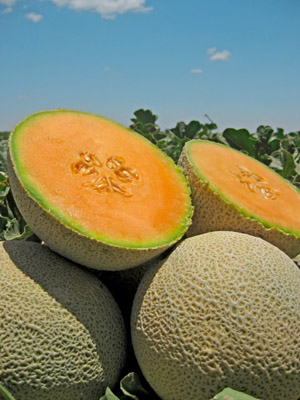by Adam Russell
Conditions have been ideal for cantaloupe and watermelon growers as the Fourth of July nears, according to Texas A&M AgriLife Extension Service experts.
Dr. Larry Stein, AgriLife Extension horticulturist, Uvalde, said dry, sunny days around most of the state’s production areas created ideal conditions for cantaloupes and watermelons to grow relatively free of disease.
Cantaloupes and watermelons are typically enjoyed in the heat of the summer, Stein said. Sales start as summer opens and then typically tail off by the end of August.

Fresh cantaloupes grown by Dixondale Farms. Cantaloupes and watermelons are experiencing an ideal growing season and high demand as the Fourth of July holiday approaches. (Courtesy photo)
Texas is the top producer of watermelons in the nation, according to the U.S. Department of Agriculture National Agricultural Statistics Service, and are the No. 1 horticultural crop in Texas, Stein said. The statewide watermelon crop in 2016 was worth more than $75 million, according to AgriLife Extension annual reports, down 25 percent from more than $100 million in 2014.
Stein said the plant’s expanding root system and ability to adapt to dry conditions on dryland fields make much of the state good for watermelon and cantaloupe production. However, several areas, such as the Lower Rio Grande Valley, and North and East Texas, have higher concentrations of fields.
Bruce Frasier of Dixondale Farms in Carrizo Springs said fruit sets were good on his cantaloupe fields and spring thunderstorms, hail and wind did not cause damage during bloom.
“Conditions were perfect for setting fruit,” he said.
Frasier said there has been very little disease or pest pressure on his 400 acres planted with cantaloupe. He said he planted seeds that were treated to fend off fungus and make plants undesirable to typical pests.
Dry conditions have also allowed harvest of the irrigated crop to continue without weather delays, he said.
“Rain at this point also dilutes the sugar content, which can hurt flavor,” he said. “We’ve been able to access fields and harvest vine-ripe cantaloupes for our customers.”
The demand for cantaloupes is growing, Frasier said. He expanded his production by 20 percent since last year and extended the growing season by having plants ready for harvest earlier this year.
Frasier said harvest of his Carrizo cantaloupes began in May and will continue until July 15, with cantaloupes shipped daily to most retailers around the state.
Dr. Juan Anciso, AgriLife Extension horticulturist, Weslaco, said the watermelon harvest in the Rio Grande Valley typically ends in May, but growers are keeping vines going to extend their season amid a high-demand, low-supply market.
“Growers are getting the best prices they’ve seen in years,” he said. “Oversupply from Mexico really impacted prices in the past few years. This year, Florida producers had trouble and Mexico scaled back pretty significantly, so people are paying more for watermelons.”
Watermelon fields in northern and eastern Texas typically enter harvest around the Fourth of July, when demand peaks, Anciso said.
July 4 falls on a Wednesday this year, and Frasier said the mid-week holiday typically means two weekends of active sales for his cantaloupe operation.
“There are the folks who will be taking off the weekend before through the holiday, and then there are the folks who will take off on the Fourth and that Thursday and Friday for a long weekend,” he said. “Retailers have to keep up with demand for cookouts and outdoor activities. That’s good for business.”
CENTRAL: Dry conditions continued, however, some isolated showers occurred. More rain was needed. Dry conditions caused stunted growth of grain sorghum, and corn was without ears in some areas. Wheat harvest was starting to wrap up with great yields. Cattle remained in good condition. Stock tanks and river water levels were dropping. Most counties reported good soil moisture. Overall crop rangeland and pasture conditions were good.



